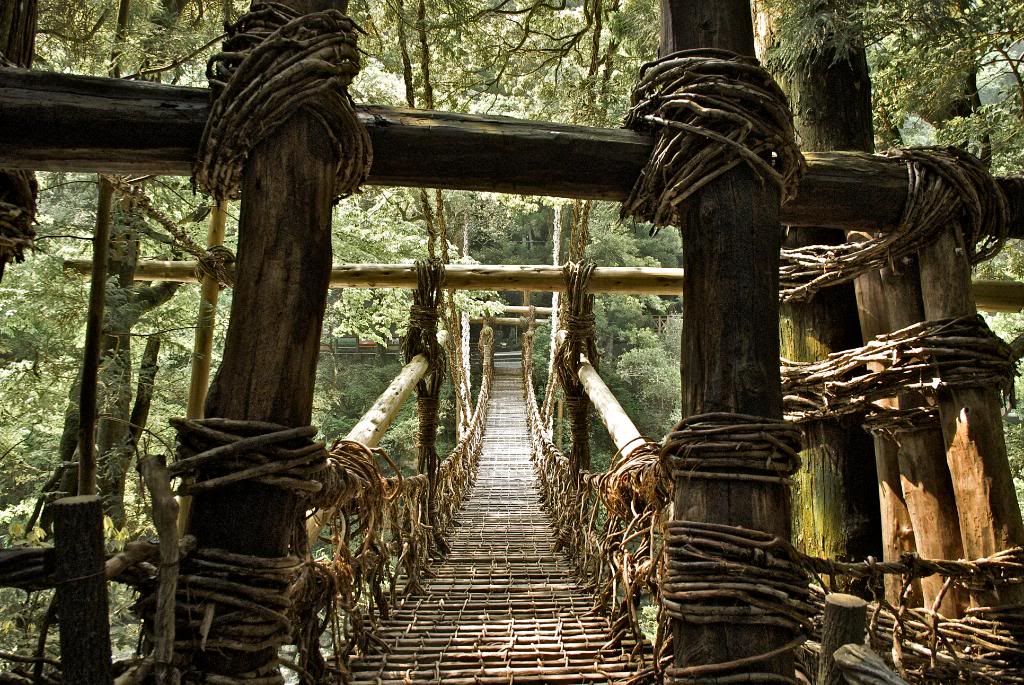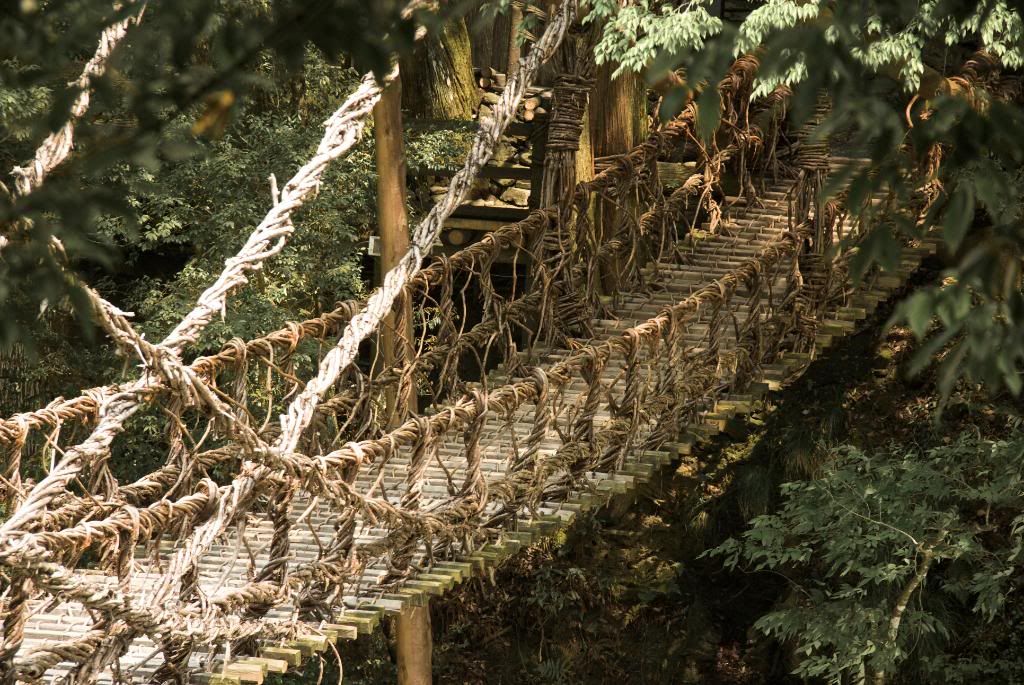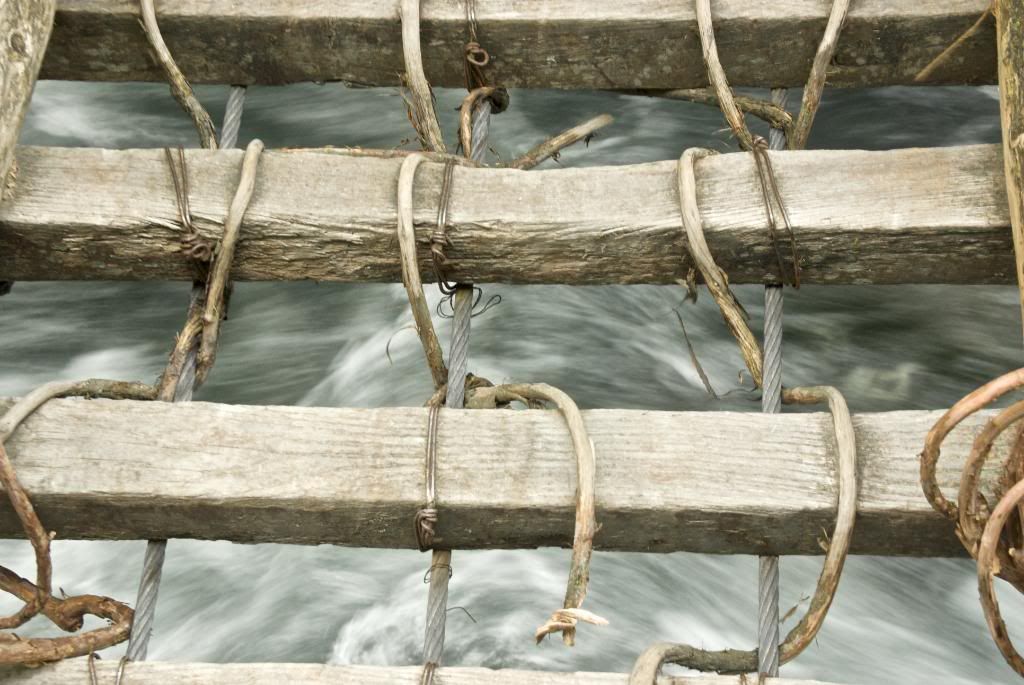 I gladly accept his offer and put my baggage on the backseat of his Toyota. It takes about ten minutes to get to Ku-Nel-Asob, a converted farmhouse in Nishi Iya (西祖谷), high above the banks of Yoshino river (see picture below), that now serves as an eco guesthouse and is widely known as a backpacker's paradise. KNA, as it is dubbed even by Nori himself, was uninhabited for 20 years, when he bought it some seven years ago. The owners had lost interest in farmlife. Since then, he's put every Yen he can spare into renovation and uphold. Not an easy task, given that eco tourism in Japan has only just started.
I gladly accept his offer and put my baggage on the backseat of his Toyota. It takes about ten minutes to get to Ku-Nel-Asob, a converted farmhouse in Nishi Iya (西祖谷), high above the banks of Yoshino river (see picture below), that now serves as an eco guesthouse and is widely known as a backpacker's paradise. KNA, as it is dubbed even by Nori himself, was uninhabited for 20 years, when he bought it some seven years ago. The owners had lost interest in farmlife. Since then, he's put every Yen he can spare into renovation and uphold. Not an easy task, given that eco tourism in Japan has only just started."Ashita o tenki ii desu, ka?" I try to break the ice, while we drive up a steep country road that abruptly ends in front of Nori's house. "It's gonna be sunny all day", he replies with an almost accent-free pronounciation, very much to my surprise. In this secluded region of Shikoku people usually don't speak foreign languages. But Nori has served a couple of years with the UN peace corps in different countries and "there was no way around learning English", he explains to me during dinner, as we talk about occupations.
 I spend the night in one of the dorms of KNA, and as I wake up next morning, Nori's father has already prepared some breakfast: rice and soup, of course. The usual diet. I skip the meal, since the bus that shall take me to Kazurabashi won't wait. And there are only three per day. After I finished studying the map of the valley, Nori gives me a lift to the bus stop.
I spend the night in one of the dorms of KNA, and as I wake up next morning, Nori's father has already prepared some breakfast: rice and soup, of course. The usual diet. I skip the meal, since the bus that shall take me to Kazurabashi won't wait. And there are only three per day. After I finished studying the map of the valley, Nori gives me a lift to the bus stop.Talking about bus services: Getting from Oboke to Higashi Iya, the eastern part of the valley, takes about two hours, if - and only if - you manage to get the connecting bus, somewhere in the middle of nowhere. Sounds like fun? Right. I missed it the other day - and was lucky only, because a friendly couple in their mid-fifties felt pity and let me jump in their deluxe limousine, despite being wet all over after I had been surprised by a heavy shower.
 Kazurabashi is a magnificent view. Legend has it that the old vine bridges - there are three in the valley, the other two being further east and yet more difficult to reach - were built some 800 years ago by Samurai warriors of Tosa prefecture, who fled from their Tokushima-based opponents that had been chasing them on behalf of the emperor. Truly a remarkable escape route! And probably the only one, since roads were not available in this area at that time. There aren't many these days either, albeit some people are concerned that, as a result of recent attempts to provide a better infrastructure in the region, Iya Valley one day will become a "valley of concrete", as Alex Kerr had coined it in "Lost Japan".
Kazurabashi is a magnificent view. Legend has it that the old vine bridges - there are three in the valley, the other two being further east and yet more difficult to reach - were built some 800 years ago by Samurai warriors of Tosa prefecture, who fled from their Tokushima-based opponents that had been chasing them on behalf of the emperor. Truly a remarkable escape route! And probably the only one, since roads were not available in this area at that time. There aren't many these days either, albeit some people are concerned that, as a result of recent attempts to provide a better infrastructure in the region, Iya Valley one day will become a "valley of concrete", as Alex Kerr had coined it in "Lost Japan". Would you dare to cross it, even without having to wear heavy armor or ride on horseback? Don't worry: It's pretty safe. The wooden construction is strengthened by steel cables (as you can see in the picture below). Provided you're free of fear of heights, it shouldn't be a problem to arrive in good shape on the other side. And the swift waters of the river are so far below that you won't even get wet feet.
Would you dare to cross it, even without having to wear heavy armor or ride on horseback? Don't worry: It's pretty safe. The wooden construction is strengthened by steel cables (as you can see in the picture below). Provided you're free of fear of heights, it shouldn't be a problem to arrive in good shape on the other side. And the swift waters of the river are so far below that you won't even get wet feet. On the other side of the bridge, there are small shops that sell refreshments and Iya Soba, a local specialty: buckwheat noodles in a soup with vegetables and/or meat. Delicious!
On the other side of the bridge, there are small shops that sell refreshments and Iya Soba, a local specialty: buckwheat noodles in a soup with vegetables and/or meat. Delicious!However, most of the shops are closed, and I wonder if it's due to off-season or rather because of the rural exodus, being commonplace in Shikoku's remote regions.
 Over the past 30 years, the villages in Iya Valley have lost roughly one third of their population. Says Alex Kerr: "Mostly young people have moved away. There are villages that make a graveyard look fresh and healthy." It is a strange mix of sarcasm and serenity that are amalgamated in his words, and he adds a pinch of melancholy to it, when he says that he still has "hopes that the traditional way of country life in Japan will not be lost forever". At least from what I have seen while traveling cross-country in Japan, those hopes cannot be high enough! ---- Part 2 of the story will take you to Chiiori House, a five-mile walk uphill, and to an abandoned village deep in the valley. Stay tuned.
Over the past 30 years, the villages in Iya Valley have lost roughly one third of their population. Says Alex Kerr: "Mostly young people have moved away. There are villages that make a graveyard look fresh and healthy." It is a strange mix of sarcasm and serenity that are amalgamated in his words, and he adds a pinch of melancholy to it, when he says that he still has "hopes that the traditional way of country life in Japan will not be lost forever". At least from what I have seen while traveling cross-country in Japan, those hopes cannot be high enough! ---- Part 2 of the story will take you to Chiiori House, a five-mile walk uphill, and to an abandoned village deep in the valley. Stay tuned.
Thanks a lot for sharing! Great story!!
ReplyDelete